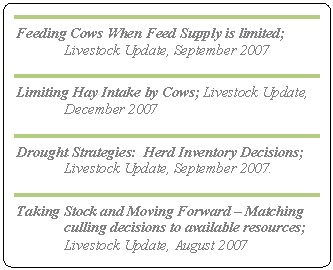
You've reached the Virginia Cooperative Extension Newsletter Archive. These files cover more than ten years of newsletters posted on our old website (through April/May 2009), and are provided for historical purposes only. As such, they may contain out-of-date references and broken links.
To see our latest newsletters and current information, visit our website at http://www.ext.vt.edu/news/.
Newsletter Archive index: http://sites.ext.vt.edu/newsletter-archive/

The Cow-Calf Manager
Livestock Update, January 2008
Dr. John B. Hall, Extension Beef Specialist, VA Tech
![]()
Feeding Spring Calving Cows in Late Gestation This Winter

Over the past several months the VT Extension Beef Team dedicated several articles to dealing with the drought (See Side Bar). These articles discuss strategies in dealing with drought and animal feeding options as well as culling decisions. Several producers and agents asked for a reminder on when these were published and the titles. These articles can be accessed at http://www.ext.vt.edu/news/ then click on Livestock Update.
More recently, I received several requests for example diets that limit hay but meet the nutritional needs of cows. Diets that use alternative feeds to allow limit feeding of hay are illustrated in Tables 1 & 2. Both tables indicate amounts of feed needed per cow per day during the 60-90 days before calving. Table 1 is for cows that need to maintain weight. Table 2 is for cows that need to gain weight or heifers about to have their first calf.
I am always concerned when I list recommended diets because not everyone’s situation or feeds are the same. These tables are for cows that weigh 1250 lbs. If your cows are a different size (probably bigger) then they need more feed. Also, the hay used in these diets is average 1st cutting fescue (50% TDN and 8.8% CP). Hay made in 2007 may be better, but unless you have it tested the nutrient content used is conservative.
Table 1. Limited Hay Diets to Maintain Weight and Body Condition in 1250 lbs. Mature Cows in Late Gestation
|
Diet 1 |
Diet 2 |
Diet 3 |
Diet 4 |
Ingredient |
Pounds (as fed) per cow per day |
|||
Hay, Fescue 1st Cutting |
10 |
10 |
10 |
10 |
Whole Shelled Corn |
0 |
5 |
0 |
0 |
Corn Gluten Feed |
10 |
5 |
0 |
0 |
Wet Brewers Grains |
0 |
0 |
50 |
0 |
Dried Distillers Grains |
0 |
0 |
0 |
9 |
Cows will neither gain nor lose weight on diets in Table 1 if weather conditions are normal to mild. If the winter turns very cold or during a short cold snap cows will lose weight on these diets if addition feed is not provided.
Table 2. Limited Hay Diets to Increase Weight and Body Condition in 1250 lbs. Mature Cows in Late Gestation
|
Diet 1 |
Diet 2 |
Diet 3 |
Diet 4 |
Ingredient |
Pounds (as fed) per cow per day |
|||
Hay, Fescue 1st Cutting |
10 |
10 |
10 |
10 |
Whole Shelled Corn |
0 |
7 |
0 |
0 |
Corn Gluten Feed |
15 |
7 |
8 |
0 |
Wet Brewers Grains |
0 |
0 |
35 |
0 |
Dried Distillers Grains |
0 |
0 |
0 |
13 |
The diets in Table 2 are designed to allow cows to gain about 1 body condition score (85-100 lbs) in 60 days. This weight gain is in addition to the weight gain needed to produce a healthy calf. Many cows in Virginia and the Mid-Atlantic region need to gain weight before calving this year.
When using diets in either Table 1 or 2, producers should be aware of the following:
Remember having cows calve in good body condition (BCS 5 or 6) is essential to a healthy calf and a cow that will rebreed quickly.